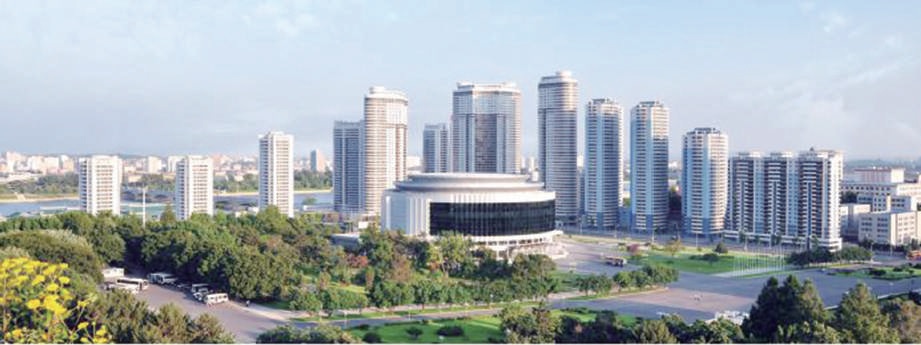朝鮮的房屋建設
朝鮮的房屋建設
Housing Construction in the DPRK


The past ten years witnessed a boom in housing construction in the Democratic People’s Republic of Korea.
Regarding housing construction as an important undertaking in providing the people with more civilized and stabler living conditions, the country channels great efforts into building dwelling houses in the capital and provinces.
Modern streets and residential districts were built one after another from 2012. They include Changjon Street in the central part of Pyongyang, Unha Scientists Street, apartment buildings for lecturers at Kim Il Sung University and Kim Chaek University of Technology, Wisong Scientists Residential District, Mirae Scientists Street and Ryomyong Street.
From then onwards, a modern street sprang up every year in Pyongyang.
Housing construction was undertaken on an unprecedented scale also in towns and rural communities in provinces.
The renovation project of the city of Samjiyon in northern Korea which had been carried out in three stages was brought to completion in 2021, four years after its start. As a model of perfect harmony of modern, national and alpine features, the city attracted the attention of the international community.
As a result of the construction of low-rise and multi-storeyed apartment houses for thousands of households and many excellent facilities, the mountainous town, 1 300 metres above sea level on average, was completely changed in the true sense of the word.


Modern houses were built one after another in many other places like Onjong-ri, Yangdok County in the middle part of the country and Sangso-ri, Poptong County in the eastern part.
In the Jungphyong area in the northeastern part, hundreds of modern houses were built for the employees of a large-scale greenhouse vegetable farm and a tree nursery.
Precedence was given to housing construction in building the Tanchon Power Station which is of great importance in the country’s power production. This clearly showed the considerate intention of the Workers’ Party of Korea and the government of the DPRK to prevent inconveniences in the life of the residents who would have to be relocated when important construction projects were undertaken.
Also worthy of note is the fact that prompt measures are taken for disaster victims.
In 2015, 2016, 2020 and 2021 many parts of the country were severely affected by flooding, heavy rains and typhoons, resulting in a number of factories, enterprises and farmland as well as houses being destroyed or inundated.
Many people around the world were concerned and pessimistic about the flood victims in the DPRK as it was suffering harsh difficulties and hardships owing to persisting blockade and sanctions by the forces hostile towards it.


However, the WPK and the government of the DPRK promptly rose to the occasion. With a view that the sufferings of the people were the biggest emergency and there was no more important work than the undertaking to relieve the people of their misfortune, they defined the construction of houses for the victims as the first priority in the rehabilitation project and mobilized all the human, material and technical potentials of the country. Thus, nice streets and villages were built in a very short span of time and the flood victims were provided with new houses.
The people around the world were surprised to see the flood victims, who they thought must be in despair, moving to new houses.
What is more surprising is the fact that the houses are built with state investment and given to them free of charge.
The scale of the country’s housing construction is getting larger and larger with the passage of time.
In March 2021 the ground-breaking ceremony for the project to build 10 000 flats was held in Pyongyang in the presence of Kim Jong Un, president of the State Affairs of the DPRK.
A big architectural group composed of 10 000 flats was formed in the Songsin and Songhwa districts and 800 luxurious houses in the Pothong riverside terraced houses district was near to completion.
The Komdok area, the country’s leading non-ferrous minerals producer, is being renovated into an unprecedentedly large mountain gorge town; 25 000 new houses are planned to be built in the miners’ town by 2025, which marks the 80th founding anniversary of the WPK.
This is not because the country has a surplus of funds in its coffer or it has good conditions; it is because the state regards it as the supreme principle of its activities to make everything serve the people and work for their wellbeing.
To be more specific, all this is thanks to the politics of love for the people, which is administered by Kim Jong Un who always pays close attention to providing a stabler and more civilized life to the people.
What he said in his speech at the above-mentioned ground-breaking ceremony is quite impressive: The Party and the government, having made themselves aware of the number of families that were in need of new houses, conducted in-depth research to determine the measures for solving the problem; they regarded this project as their most important task; and nothing is more worthwhile, honourable, or happier, for us than to dedicate our sweat and passion, without hesitation, to building an ideal street that will be a warm home for our people.


Source: Consulate General of the Democratic People’s Republic of Korea in Hong Kong
- Log in to post comments





